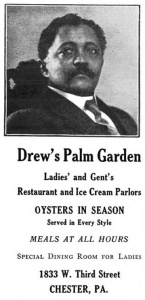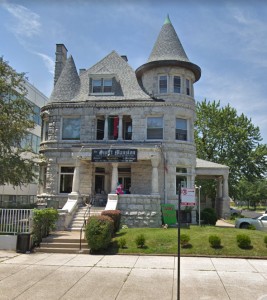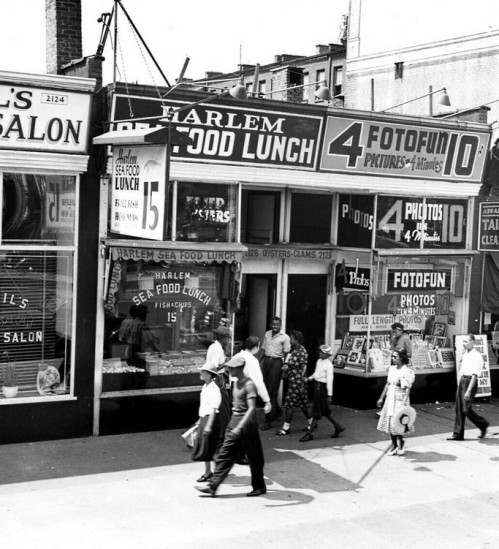Before the 1960s, the term “soul food” wasn’t used in reference to food. Until then the words had religious connotations for Protestants.
What became known as edible soul food, such as chitterlings, pigs’ feet, greens, black-eyed peas, cornbread, and cobbler (to name just a few), had been popular in the South long before the words soul food were applied. But the diet gained a charged meaning in the 1960s when proponents of Black Power affirmed eating soul food as a political statement.
By any name, soul food was not often found in restaurants outside the South until African-Americans began migrating northward before, during, and after World Wars I and II. Walker’s Café in Wichita KS advertised chitterlings and catfish in 1910. That same year the Gopher Grill in St. Paul MN claimed to be “headquarters for chitterlings and corn bread.” Similar menus were often found at dinners at Black churches and homes. Women belonging to the Social and Literary society of a Baptist church in St. Paul MN dressed in Colonial costumes and hosted a chicken and chitterlings dinner in 1916 to celebrate Lincoln’s birthday, an event where the identity politics were quite different than what would develop in the Black Power movement.
 There were also numerous restaurants owned and patronized by Blacks in the North that did not serve soul food, or at least didn’t specialize in it. It’s difficult to find menus from restaurants of the migration periods, but when their advertisements mentioned specialties, they were often similar to dishes in white restaurants. A Chester PA restaurant specialized in oysters in 1910. In Black’s Blue Book for 1923-1924 — which listed Chicago’s prominent African-American citizens, along with recommended businesses — there were only four restaurants that advertised what kinds of dishes they served. Those dishes were Barbecued Chicken, Duck, and Squab; Chicken Salad; Club Sandwiches; Sea Foods; and Chili Con Carne (at two restaurants).
There were also numerous restaurants owned and patronized by Blacks in the North that did not serve soul food, or at least didn’t specialize in it. It’s difficult to find menus from restaurants of the migration periods, but when their advertisements mentioned specialties, they were often similar to dishes in white restaurants. A Chester PA restaurant specialized in oysters in 1910. In Black’s Blue Book for 1923-1924 — which listed Chicago’s prominent African-American citizens, along with recommended businesses — there were only four restaurants that advertised what kinds of dishes they served. Those dishes were Barbecued Chicken, Duck, and Squab; Chicken Salad; Club Sandwiches; Sea Foods; and Chili Con Carne (at two restaurants).
 The spectrum of eating places found in New York’s Harlem, Chicago’s Black Belt, and Black urban neighborhoods across the North ranged from down-home, all-night eateries serving factory shift workers to elegant tea rooms lodged in old mansions that hosted patrons with more money and leisure. In Chicago, leaders of the N.A.A.C.P., the Urban League, and visiting foreign dignitaries were inevitably entertained with dinners at top Black tea rooms such as The Ideal, the Bird Cage [pictured, 2018], and the University tea rooms. In Spring 1923, the University Tea Room (“The Most Beautiful Spot in Chicago”) advertised the following menu:
The spectrum of eating places found in New York’s Harlem, Chicago’s Black Belt, and Black urban neighborhoods across the North ranged from down-home, all-night eateries serving factory shift workers to elegant tea rooms lodged in old mansions that hosted patrons with more money and leisure. In Chicago, leaders of the N.A.A.C.P., the Urban League, and visiting foreign dignitaries were inevitably entertained with dinners at top Black tea rooms such as The Ideal, the Bird Cage [pictured, 2018], and the University tea rooms. In Spring 1923, the University Tea Room (“The Most Beautiful Spot in Chicago”) advertised the following menu:
65c – Special Table de Hote Dinner – 65c
Cream of Tomato Soup
Roast Chicken with Dressing
Spring Lamb with Peas
Snowflake Potatoes
June Peas in Cases
Salad
Head Lettuce and Tomatoes
French Dressing
Dessert
Apple Pie with Cheese
Rice Pudding
Coffee
Strawberry Shortcake, 25c
Ice Cream, 10c
Strangely enough, the 1966-1967 version of the Green Book failed to list some prominent Black restaurants with barbecue such as Arthur Bryant and Gates in Kansas City, and soul food places such as Soul Queen and H & H in Chicago. For New York City, it broke restaurant listings into the categories Steaks, American Specialties, Seafood, and Chinese – but not Soul Food.
While some Northern Blacks slowly accepted soul food, others were more resistant. This seemed to hold especially true for those higher in social status. Some of Chicago’s Bronzeville residents who held themselves superior to migrants expressed criticism of newcomers’ food customs, such as eating chitterlings. A journalist writing in the New York Amsterdam News in 1931 claimed that Harlemites rejected the “Fried Chicken, Pork Chop, Hog Maw and Chitterlings Theories” that assumed all Blacks liked rural Southern food. He also disavowed any special attraction to watermelon.
 In 1945 another reporter from the Amsterdam News set out to find chitterlings in Harlem restaurants. He found only one restaurant serving them (Rosalie’s and Frances’ Clam House and Restaurant). He reported that Harlemites were just as likely to eat Chock Full O’ Nuts’ nutted cream sandwiches, Chicken Fricassee, Weiner Schnitzel, or Oysters Casino. At the same time, he observed that whites visiting Harlem enjoyed spare ribs with red beans, concluding, “there are no fundamental points of difference between eating habits of Harlemites and those of the lighter-skinned folk downtown.”
In 1945 another reporter from the Amsterdam News set out to find chitterlings in Harlem restaurants. He found only one restaurant serving them (Rosalie’s and Frances’ Clam House and Restaurant). He reported that Harlemites were just as likely to eat Chock Full O’ Nuts’ nutted cream sandwiches, Chicken Fricassee, Weiner Schnitzel, or Oysters Casino. At the same time, he observed that whites visiting Harlem enjoyed spare ribs with red beans, concluding, “there are no fundamental points of difference between eating habits of Harlemites and those of the lighter-skinned folk downtown.”
Most soul food histories note that some prominent Black leaders have rejected soul food, pointing to Eldridge Cleaver of the Black Panthers and Nation of Islam leader Elijah Muhammad. In his book Soul Food, Adrian Miller observed that Cleaver wrote in Soul on Ice (1968), “The emphasis on Soul Food is counter-revolutionary black bourgeois ideology.” Instead, wrote Cleaver, “The people in the ghetto want steaks. Beef Steaks.” Elijah Muhammad denounced soul food as a legacy of slavery that should be decisively rejected.
 Miller laments the decline of restaurants that serve soul food, marked by the closure of landmarks such as Army and Lou’s and Soul Queen in Chicago. “Across the country, legendary soul food restaurants are disappearing at an alarming pace,” he writes, attributing it to health concerns and reduced business prospects due to the scattering of African-American communities and the popularity of fast food.
Miller laments the decline of restaurants that serve soul food, marked by the closure of landmarks such as Army and Lou’s and Soul Queen in Chicago. “Across the country, legendary soul food restaurants are disappearing at an alarming pace,” he writes, attributing it to health concerns and reduced business prospects due to the scattering of African-American communities and the popularity of fast food.
With a few exceptions, I don’t think the views of critics such as Cleaver are seen as valid now. And there seems to be a renaissance of interest in soul food among Black chefs and restaurateurs who celebrate it as part of a heritage of resilience and creativity under slavery. Somewhat surprisingly, even vegan soul food restaurants can be found now.
© Jan Whitaker, 2019













 It's great to hear from readers and I take time to answer queries. I can't always find what you are looking for, but I do appreciate getting thank yous no matter what the outcome.
It's great to hear from readers and I take time to answer queries. I can't always find what you are looking for, but I do appreciate getting thank yous no matter what the outcome.



Love this. Army & Lou’s reopened by my 3 friends. in October 1994 one of the owners let a fired employee in after closing. He murdered him…took the safe…went and bought drugs. The owners wife and daughter came looking for him when he did not come home to find him murdered at his desk.
I am still devastated. He was an extraordinary human being.
How horrible, Sandra!
Pingback: Soul Food Restaurants in NYC - Men Who Brunch
Reblogged this on Men Who Brunch and commented:
Great read. It’s interesting to find out that soul food was not served even in some black restaurants.
Shook my taste buds up reading this blog. Have some wonderful history about Army and Lou’s. Have eaten there with new and old owners. They served fine dining and liquor. Lived the history with 2 African American Businessmen who created frozen chitterling and chicken dinners with spaghetti with greens dinners. German chef created the nutrtional labeling for packaging. They had a line of soul food & greens seasonings. I was their event caterer and presented in store demonstrations. They had quite a following!!
Great job as always!!
Sandra, you are definitely a food historian. You should start a blog!
Fascinating! Another beautifully researched, illustrated, and written post. Enjoyed reading it.
Oh, what an absolutely gorgeous building that Bird Cage tea room is!
I think it’s one of the dilemmas of many celebrations of so-called “ethnic food” or “comfort food” — is the connection to foods of poverty and oppression too much identification with that status or a triumph over it?